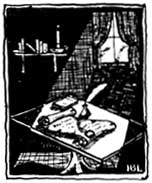|
NOT A JÄGER
The Regional Review wishes to rectify an error
which it made in its last issue, (Vol. V, No. 1) in selecting
illustrations to accompany Dr. Carl P. Russell's scholarly article, "The
American Rifle at the Battle of Kings Mountain." The caption under the
two pieces illustrated on page 17 described one of them as a German
Jäger. In reality it was a musket. The upper drawing reproduced
below shows a Jäger in scale with the Kentucky rifle under it.
The J&amul;ger, brought to America during the
Revolution, was by no means the equal of the American piece. It was
short-barreled and took a ball of 19 to the pound. With its large ball
and small powder charge its recoil was heavy and its accurate range but
little greater than that of the smoothbore musket. Like the rifle
introduced from Switzerland and Austria in about 1700, it was short,
heavy and clumsy.

ORGANIZED CAMP USE SHOWS 53 PER CENT
INCREASE
A gain of approximately 53 per cent in the total of
camper days is indicated in a report covering use of organized camp
sites in recreational demonstration areas of the eastern region of the
National Park Service for the first half of the calendar year. For the
period January 1-June 30, a total of 32,967 camper days was recorded for
the 50 organized camps and tent camping sites, an increase of 11,417
over the corresponding period of 1939.
The total for all visitors to the areas during the
six months was set at 369,983 against 338,477 for 1939. Total visitors
and camper days reached 402,950, a gain of 42,923 over the first
half-year of 1939. All figures are the highest recorded since the
inception of the recreational demonstration area program.
The chief factors contributing to longer periods of
use of camping facilities are believed to be more extensive short-term
occupation of sites, greater coordination of community camp planning,
the introduction of camping by more agencies as a part of their
year-round recreational-educational programs, and the ability of some of
the agencies to enlist additional public support of camping enterprises.
Seven camps were conducted almost entirely for subsidized campers.
Several agencies provided camping opportunities, financed by donations
from private individuals, for boys and girls of low-income families.
Low-cost camps were found to be increasing, some organizations providing
programs at $5 a week; four groups, with partly subsidized staffs,
conducted satisfactory camps at $4 a week or less.
Several federal and state agencies conducted
recreational leadership training courses at no charge to the sponsoring
organizations, an activity which has grown out of a realization that
good leadership is fundamental to superior programs and that the supply
of qualified leaders remains inadequate.
Although most of the camps conducted during the first
half of this year were for boys and girls---many of them
co-educational---two agencies sponsored programs for families and young
adults. Two other organizations scheduled periods of family camping at
the close of their established camps for boys and girls.
TRAVEL RECORDS BROKEN IN GREAT SMOKIES
A record total of visitors has been reported by Great
Smoky Mountains National Park, North-Carolina-Tennessee, for the travel
year ended September 30. The annual report showed that 860,960 persons
traveling in 267, 789 vehicles entered the park during the period, an
increase of 13 per cent over the previous (1929) record. August 1940 was
the greatest travel month of the park's existence, a total of 202,368
persons having been counted. The heaviest single day was September 1
when 18,549 visitors entered the area.
, Shenandoah National Park, Virginia, which has lead
the national system's travel totals for several seasons, recorded
950,807 visitors for 1940 as against 911,612 for 1939. Early reports
from most of the national parks and monuments indicate substantial gains
in travel throughout the country.

| 
